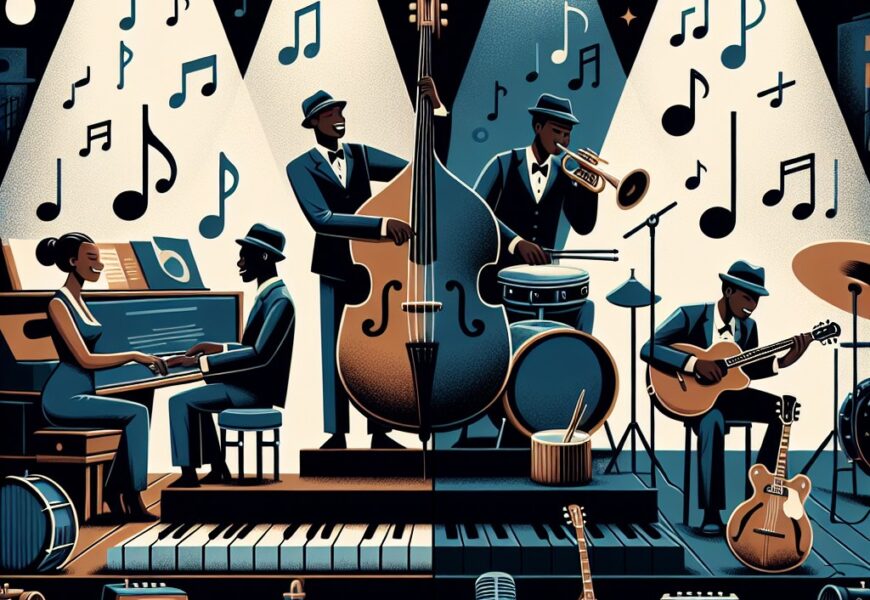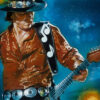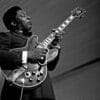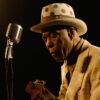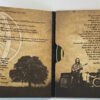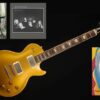Jazz is characterized by its complex harmonies and improvisational play, while Blues centers on soulful melodies and lyrical storytelling. Both genres have deep roots in African-American history.
Jazz and Blues music are two distinct genres that have shaped the cultural landscape of America. Originating in the late 19th and early 20th centuries, they carry the emotional weight of African American experiences. Jazz often offers energetic, syncopated rhythms and focuses on the artistry of instrumental improvisation.
On the other hand, Blues usually conveys a more straightforward and repetitive structure, emphasizing evocative lyrics to express life’s hardships and triumphs. Despite their differences, both styles have profoundly influenced various music genres, reflecting a rich heritage and evolving with each generation of musicians. Each genre serves as a canvas for emotional expression, storytelling, and cultural identity, echoing the soul of American music tradition.
History
Exploring the roots of two powerful music genres reveals rich cultural tapestries. Jazz and Blues, while distinct in their essence, share deep historical connections. Both genres emerged from the African American experience in the United States and evolved to shape music worldwide. Their histories, colored by emotion and expression, diverge and intertwine throughout the decades.
Origins Of Jazz
Jazz’s birth took place in New Orleans at the turn of the 20th century. Its cradle, a melting pot of culture, fused African rhythms, European harmonies, and American popular music.
Key figures include Louis Armstrong and Duke Ellington. They helped catapult jazz from local dance halls to global stages. Jazz evoked the complexity of modern life, often improvised and brimming with creativity.
Origins Of Blues
The Blues sprang from the deep South, particularly the Mississippi Delta, after the Civil War. This genre expressed the sorrows and hopes of African American workers. Emotional vocals and the call-and-response pattern laid its groundwork.
Legends like Robert Johnson and Bessie Smith poured their lives into soul-stirring songs. Their influential blues narratives paved the way for rock and roll and R&B.
Musical Characteristics
Exploring the soulful realms of Jazz and Blues reveals a tapestry woven with rhythmic pulses, melodic tales, and instrumental dialogues. Each genre, distinct yet interlinked, thrums to its own beat, sings its unique song, and dances with a special set of instruments. Let us dive deep into the musical characteristics that define Jazz and Blues.
Rhythm And Tempo
Jazz often swings with syncopation, where beats are sharp and unpredictable. Its tempo can change, from slow to fast in a single tune. In contrast, Blues keeps a steadier pace, known for its shuffle or a slow-burning groove that keeps feet tapping consistently.
Melody And Harmony
- Jazz melodies twist and turn, showing off a wide range of notes. Jazz players love to improvise, creating new melodies on the spot.
- Blues melodies are simpler. They stick to the heart of the song, often repeating a memorable pattern with slight variations.
Harmonically, Jazz explores complex chords. In Blues, harmony comes from the use of the I-IV-V chord progression, which is much simpler yet powerful.
Instrumentation
| Jazz Instruments | Blues Instruments |
|---|---|
| Saxophone | Guitar |
| Piano | Harmonica |
| Trumpet | Piano |
| Double Bass | Bass Guitar |
| Drums | Drums |
Jazz ensembles often feature a blend of woodwind, brass, and rhythm sections. Blues bands are noted for their expressive use of guitars and harmonicas, instruments that cry out the soulful tunes.
Improvisation
Improvisation stands at the heart of jazz and blues, breathing life into every performance. Both jazz and blues use improvisation, but in different ways. Improvisation means creating music on the spot.
Jazz Improvisation
Jazz music thrives on spontaneous creation. Jazz artists often take turns playing solos. They might use scales and chords in new ways. Each performer adds their unique twist to the piece. This interaction leads to lively and sometimes surprising music. Musicians often respond to each other in real-time. They may change the rhythm, melody, or harmony.
Notable jazz improvisation methods include:
- Scat singing where vocalists use nonsensical syllables.
- Modal improvisation, using scales for melodies.
- Swing, which puts stress on certain beats.
Blues Improvisation
Blues improvisation is more about expressing feelings. It sticks to the blues scale. Artists often emphasize the bending of notes. This gives the music a particular emotional sound.
The structure of blues is usually a 12-bar pattern. This pattern is like a canvas for artists. They paint their feelings with notes. Blues players often repeat lines. This adds to the soulful expression of the music.
Key elements in blues improvisation include:
| Element | Description |
|---|---|
| Call and Response | A method where one phrase is answered by another. |
| Note Bending | Technique that adds a wailing sound to notes. |
| Vibrato | This shakes the note to add emotion. |
Form And Structure
The entwined rhythms and melodies of Jazz and Blues carry distinct tales through their form and structure. While both genres echo the depths of American history, their expression in musical architecture sets them apart. Let’s uncover the frameworks that shape the bold sounds of Jazz and the soulful tunes of Blues.
Jazz Forms
Jazz, recognized for its complex and varied forms, often embraces a level of improvisation that shapes its structure. Here are some staple forms:
- 32-Bar AABA: The gold standard in Jazz, marked by a repeating pattern where ‘A’ represents the main theme and ‘B’ introduces a contrasting bridge.
- 12-Bar Blues: While inherent in Blues, this form also finds its place in Jazz, providing a backbone for spontaneous variation.
- Bebop: With rapid chord changes and unpredictable rhythms, bebop is a testament to Jazz’s dynamic nature.
Each form serves as a canvas where musicians paint with notes, turning each performance into a unique musical experience.
Blues Forms
Blues music, steeped in emotional expression, utilizes more straightforward structures compared to Jazz:
| Form | Description |
|---|---|
| 12-Bar Blues | The foundational framework consisting of a set chord progression over 12 bars, embodying the soul of Blues. |
| 8-Bar Blues | A less common variation, often featured in ballads and gospel music, providing a compact storytelling approach. |
| 16-Bar Blues | An extended form offering more space for narrative and emotional depth within the music. |
The unyielding structure of Blues forms creates a repetitive comfort, setting the stage for powerful lyrical storytelling.
Influence And Evolution
The journey of music is full of twists and turns. Jazz and Blues hold unique spots in the history of music. They have shaped not just their own genres but also a vast array of other musical styles. These two genres share deep roots but have evolved distinctly over time.
Jazz and Blues have woven their influence through many forms of music. They stirred up waves that still ripple through today’s sounds. Their evolution tells the story of America’s cultural history and its impact on the world.
Impact On Other Genres
Rock ‘n’ Roll, R&B, and even Hip-Hop stand on the shoulders of Jazz and Blues. Swing rhythms and improvisation in Jazz led to the birth of genres like Bebop and Funk. Blues gave us the 12-bar chord progression, vital in Rock music’s foundation. Artists like The Beatles and Led Zeppelin drew heavily from these roots.
Evolution Of Jazz And Blues
Jazz started in New Orleans, blending African rhythms with European instruments. It grew into styles like Swing, Bebop, and Fusion. Blues, born from African American spirituals, evolved into Electric Blues and Rhythm and Blues (R&B), influencing modern music greatly.
| Jazz Evolution | Blues Evolution |
|---|---|
| New Orleans Jazz | Delta Blues |
| Swing | Chicago Blues |
| Bebop | Electric Blues |
| Fusion | RB |

Credit: www.reddit.com
Notable Artists
Great tunes fill the air when Jazz and Blues artists hit the stage. Jazz and Blues stir the soul with rich history and powerful performances. Now, let’s meet the iconic figures of these genres.
Jazz Legends
Jazz swings with improvisation and complex rhythms. Jazz legends mesmerized fans worldwide, turning each note into a story.
- Louis Armstrong – His trumpet led Jazz to new heights.
- Miles Davis – A maestro with a moving sound.
- Ella Fitzgerald – Known for her stunning vocal improvisation.
- Duke Ellington – Piano genius and big band leader.
- Charlie Parker – Saxophonist who shaped Bebop.
Each of these artists brought something unique to Jazz, creating a timeless legacy.
Blues Legends
Blues hits the heart with soulful melodies and heartfelt lyrics. Blues legends crafted music that echoes through the ages.
- B.B. King – The King of Blues and his beloved guitar, Lucille.
- Muddy Waters – His deep voice and guitar defined modern Blues.
- Etta James – Her powerful voice cuts deep into the soul.
- Robert Johnson – A pioneer with a legendary story.
- Howlin’ Wolf – A towering figure with a booming voice.
These Blues artists’ songs tell stories of life, love, and hardship.
Emotional Expression
Emotional Expression in Jazz and Blues plays a vital role in delivering each genre’s unique experiences. The way musicians convey feelings through their instruments sets these music styles apart. Exploring the emotional landscape of Jazz and Blues reveals different themes and expressions.
Emotional Themes In Jazz
Jazz often reflects a vast spectrum of emotions. Artists use improvisation to express freedom and creativity. This genre can uplift with its energetic tones or soothe with slower melodies. Jazz integrates diverse emotional themes:
- Optimism: Bright horns and swing rhythms express joy and hope.
- Sophistication: Complex arrangements exhibit elegance and class.
- Nostalgia: Old-time sounds bring the sweet warmth of the past.
Jazz captures life’s spontaneity. It can shift moods swiftly, just like real-life emotions.
Emotional Themes In Blues
Blues has a distinct emotional core, often associated with sorrow and hardship. However, it also embodies resilience and authenticity. Common emotional elements include:
| Theme | Expression |
|---|---|
| Heartache: | Soulful lyrics and moaning guitars convey loss. |
| Struggle: | Rhythmic intensity reflects life’s challenges. |
| Troubled Soul: | Deep vocal tones bear the weight of personal stories. |
Blues serves as an emotional outlet. It connects listeners through shared experiences.
Cultural Significance
The cultural significance of jazz and blues cannot be overstated. Both genres stand as towering monuments in the landscape of American music. They’ve molded artistic expression and given voice to generations. Each genre holds a mirror to the social and historical changes of its time.
Social And Political Influence
Jazz and blues have long been reflectors of social strife and political currents. Artists used their craft to cast a spotlight on injustices and voice the struggles of the African American community. The improvisational nature of jazz embodied the aspirations for freedom and equality.
- Jazz – A medium for protest during the civil rights movement.
- Blues – Its mournful tones and soulful lyrics spoke of the deep-seated blues of the oppressed.
Impact On Society
Jazz and blues have not only influenced music but also ushered in significant cultural shifts. Both genres have fostered new social norms and contributed to changes in fashion, language, and everyday life.
| Jazz | Blues |
|---|---|
| Roaring Twenties | Working-class roots |
| Sparked the Jazz Age, flapper culture, and new dance crazes. | Echoed the sentiments of hard labor and provided an emotional outlet. |
Both genres strongly influenced subsequent musical styles, shaping what the masses would listen to and how music would be experienced by wider audiences.
Global Reach
Jazz and Blues echo beyond their birthplaces, touching hearts worldwide. Their unique rhythms and melodies speak a universal language. Each genre has influenced countless artists. Let’s explore their international impact.
International Influence Of Jazz
Jazz, born in the American South, quickly spread its wings across oceans. Musicians from every continent have embraced Jazz. They blend it with local sounds. This fusion creates new, exciting music genres. Jazz festivals pack cities like Montreux, North Sea, and Montreal every year. These events unite music lovers from different backgrounds.
- Japan: embraces Jazz with a deep passion. Tokyo Jazz Festival showcases global talent.
- Europe: developed distinct Jazz styles. Gypsy Jazz in France is an example.
- Africa: South African Jazz mixes local ethnic music with Jazz harmonies.
Global Appeal Of Blues
Blues reach out from the American Deep South to the world. Its heartfelt expression of the human experience crosses all cultural barriers. International artists often pay homage to Blues roots. They fuse traditional Blues with their cultural music.
The Blues tells a story that everyone understands. It’s about life, love, struggle, and joy. Fans across continents flock to Blues festivals. The Byron Bay Bluesfest in Australia brings together fans and musicians from all over the globe.
- United Kingdom: The British Blues Boom birthed rock legends.
- Latin America: Blues combines with Latin beats to create captivating sounds.
- Asia: Blues influences music scenes in countries like India and Japan.
Instruments
Dive into the world of music where instruments are the storytellers. Jazz and Blues may sound similar, but their instruments spin different yarns. Let’s explore these differences.
Key Instruments In Jazz
Jazz thrives on improvisation and its instruments reflect this dynamic nature.
- Saxophone: Brings a smooth, rich sound.
- Trumpet: Delivers the sharp, vibrant calls.
- Piano: Offers both harmony and rhythm.
- Double bass: Provides the rhythmic backbone.
- Drums: Keep the beat fluid and lively.
From the clarinet to the trombone, each one adds its own voice to the jazz ensemble.
Key Instruments In Blues
The soulful sound of Blues comes from a blend of heartfelt instruments.
- Guitar: Often the lead, carrying deep emotions.
- Harmonica: Adds a piercing heartfelt wail.
- Piano: Strikes chords of melancholy.
- Bass guitar: Holds down the groove.
- Drums: Provide a steady pulse.
Blues music also welcomes the saxophone for its moody whispers.
Vocal Styles
Jazz and Blues both tell powerful stories through music, each with a unique voice. In the world of melodic storytelling, vocal styles play a key role in distinguishing these two genres. The way singers express lyrics in Jazz and Blues can be as important as the music itself. Let’s dive into the distinctive vocal techniques that define Jazz and Blues.
Jazz Vocal Techniques
Jazz singers often use a technique called ‘scat singing’. This is where they use their voice as an instrument. They create melodies using syllables without any actual words. Jazz vocalists are known for their improvisation skills. They often change the melody and rhythm of songs live. This keeps performances fresh and exciting.
- Vibrato: Jazz singers use this to add warmth and texture to notes.
- Call and Response: A technique where the singer echoes the melody, like a musical conversation.
- Polyrhythms: Singers layer multiple rhythms, creating a complex, captivating sound.
Blues Vocal Techniques
Blues vocalists pour emotion into their voice to connect with listeners. The Blues style is raw and often sounds like the singer is sharing a personal story. These singers use a variety of expressive techniques and are known for their soulful delivery.
- Bends and Slides: Blues artists often bend notes, sliding into pitches for emotional effect.
- Raspy Voice: This gravelly style can convey the struggle or pain behind the lyrics.
- Repetition: Repeating lines in a song emphasizes the message and creates a hypnotic effect.
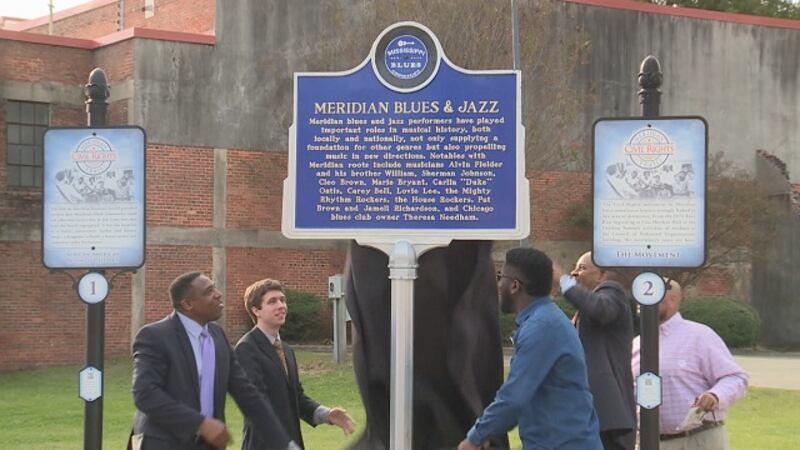
Credit: www.wtok.com
Notation And Composition
The notations and compositions in music build the framework for melodies and rhythms. In the captivating worlds of Jazz and Blues, these elements define their unique identities. Understanding the building blocks for these genres enhances appreciation for their artistry.
Jazz Composition Techniques
Dive into the Jazz composition and one finds a realm of complex harmony and spontaneous creation. These techniques set Jazz apart:
- Improvisation: Jazz musicians often create new melodies on the spot.
- Swing Rhythm: A distinctive feature that gives Jazz its characteristic groove.
- Complex Chords: Jazz compositions frequently use extended and altered chords.
- Modal Harmony: Scales or “modes” serve as the foundation for creating musical lines.
- Interactive Play: Band members respond to each other, creating a conversation.
Blues Notation Styles
The Blues roots itself in simple, soul-stirring patterns. Blues notation is known for its clarity and emotive power:
- 12-Bar Structure: A common chord progression forming the basis of many Blues songs.
- Shuffle Rhythm: A “swung” feel that is essential to the Blues sound.
- Blue Notes: Specific notes, typically flattened thirds and sevenths, provide a melancholic feel.
- Call and Response: A dialogue between the singer and the instrument, echoing African musical traditions.
- Repetitive Patterns: Simple, catchy patterns for ease of memorization and improvisation.
Dance And Performance
The world of dance and performance twinkles with the captivating energy of Jazz and Blues. Both dance forms reflect their musical counterparts, brimming with emotion and history. So, let’s don the dancing shoes and explore what distinguishes the enthralling movements of Jazz dance from the soulful expressions of Blues performances.
Jazz Dance Styles
Jazz dance sways with a rhythmic freedom that excites audiences. Its roots in African dance blend with European ballet to create a vivid tapestry of styles. Modern Jazz, known for its theatrical flair and storytelling, contrasts sharply with the spontaneous and groovy Street Jazz. Each style celebrates individual expression through improvisation and intricate footwork.
- Lindy Hop: a bubbly partner dance that turns and twirls with the big band sounds.
- Tap Jazz: creates dynamic rhythms by tapping shoes on the floor.
- Bebop: intricate, fast-paced moves that match the swift jazz music tempo.
Blues Performance Traditions
Blues performances carry the depth of the music’s emotion. They tell stories of life’s struggles and joys with each soul-stirred step. Unlike Jazz, Blues dance is less about structured moves and more about the dialogue between dancers and the music. Every performance becomes unique, embedding the dancer’s feelings into the dance’s core.
Traditional Blues dances feature:
| Dance Style | Main Characteristics |
|---|---|
| Slow Drag | Close embrace, smooth dragging steps. |
| Jookin’ | Improvised, with a laid-back, bouncing rhythm. |
| Ballroomin’ | Elegant and fluid, with large, traveling movements. |
Call and Response performances where dancers react to the musicians, create an intimate and interactive experience that defines Blues performances.
Recording And Production
The magic of Jazz and Blues music comes alive when artists hit the recording studio. Recording and production allow these genres to reach audiences far and wide. Each has its unique approach to capturing the essence of their sound. Let’s delve into the history of jazz recording and the production techniques of blues.
Jazz Recording History
Jazz burst onto the scene in the early 20th century. Musicians performed live, their music a spontaneous burst of creativity. Unlike live sessions, recording required precise techniques to capture every nuance. Early jazz was first recorded on phonographs and 78 rpm records.
- 1920s – Introduction of microphones improved sound capture.
- 1930s – The swing era benefitted from electrical recording.
- 1940s and 1950s – The emergence of magnetic tape allowed for editing and better quality.
Advancements in multitrack recording in the 1960s ushered in a new age for jazz. It gave producers the ability to isolate instruments and experiment with sound.
Blues Production Techniques
Blues, with its deep roots in African American history, focuses on raw emotion and storytelling. The production process often seeks to preserve the authenticity of the live performance.
| Period | Technique | Impact |
|---|---|---|
| Early 1900s | Acoustic recording | Captured the raw essence of blues |
| Mid-1900s | Electric recording | Enhanced clarity and volume |
| Modern Era | Analog and digital recording | Greater control over sound |
Despite advancements, many blues producers prefer minimalist techniques. They use simple setups and avoid overproduction to maintain the grit inherent in blues music.
Cross-genre Collaborations
The marriage of musical genres breathes new life into old melodies. Jazz and Blues, with their rich histories, collaborate seamlessly, transcending boundaries to create something entirely fresh. Cross-Genre Collaborations have allowed artists to explore uncharted territories, fusing traditional elements with innovative twists.
Jazz Fusion Genres
Jazz Fusion marks the blending of Jazz with other styles. It molds the intuitive improvisation of Jazz into various forms.
- Jazz-Rock mixes the complexity of Jazz with the energy of rock.
- Latin Jazz adds the rhythms of Latin American music.
- Jazz-Funk brings in a groove with soulful beats.
Blues Collaborations
Blues, known for its soul-stirring quality, finds new expressions through collaborations. Artists from different backgrounds use the Blues to convey universal emotions.
| Collaboration | Description |
|---|---|
| Blues Rock | Integrates Blues’ emotive core with the raw power of rock. |
| Rhythm and Blues (R&B) | Harmonious blend with pop, soul, and hip-hop. |
| Soul Blues | Merges Blues with soul, creating a heartfelt sound. |

Credit: www.amazon.com
Educational Programs
Welcome to the world of Jazz and Blues education! Exploring these musical genres not only enhances appreciation but also offers a transformative experience. Engaging in dedicated educational programs can unravel the complexities and unique characteristics distinguishing Jazz from Blues.
Jazz Education Initiatives
Jazz Education Initiatives conduct a symphony of programs. These initiatives focus on broadening knowledge and enhancing skills for budding musicians.
- School partnerships for curriculum development
- Interactive masterclasses by renowned jazz artists
- Jazz history and theory courses
- Performance ensembles and improvisation workshops
- Scholarship programs for aspiring talent
Blues Music Workshops
Blues Music Workshops strike a chord with emotion and storytelling — core aspects of Blues. These workshops focus on nurturing the soulful expression inherent in Blues tradition.
- Introduction to Blues scales and chord progressions
- Crafting the 12-bar blues format
- Developing skills in slide guitar and harmonica
- Lyric writing sessions with a focus on the storytelling aspect of Blues
- Live performance opportunities in local Blues clubs
The Influence Of Technology
The Influence of Technology on music extends to its creation, distribution, and enjoyment. It shapes how we experience tracks from toe-tapping Jazz to soul-stirring Blues. Technology continues to evolve. So does its role in how we interact with these musical genres.
Technological Impact On Jazz
Technology revolutionized Jazz in many ways. The advent of electric instruments allowed for new sounds.
- Electric Guitars brought rich, amplified tones to Jazz ensembles.
- Synthesizers introduced myriad textures and layers to compositions.
Recording tech gave birth to multi-track options. Artists could now overlay multiple takes. This led to richer, more complex Jazz pieces. It encouraged creativity and experimentation.
Jazz artists embraced platforms like YouTube and Spotify. They reach wider audiences. They share live performances. They even teach Jazz online.
Blues In The Digital Age
Blues music found a new life in the digital realm. Online archives preserve classic Blues songs. Fans discover old hits online.
Streaming Services make accessing Blues music easy and fast. Playlists and recommendations help new listeners find Blues artists.
Digital tools allow musicians to produce and edit tracks from home. They use software to edit songs like studio pros.
Social media platforms let Blues artists connect with fans. They share updates. They announce shows. Fans interact directly with their favorite artists.
Commercial Success
The commercial success of music genres can shift like the notes in a melody. Jazz and Blues tell stories of both struggle and triumph. They reached the ears of many worldwide. Their impact on music charts and culture has varied. Let’s dive into how each genre has found its place in the market.
Jazz In Mainstream Media
Jazz swung into the mainstream with its distinct sound. It went from clubs to radios and TVs. Movies and ads often feature jazz music. Its tunes play behind some famous brands’ commercials. Big names in Jazz, like Louis Armstrong and Ella Fitzgerald, became household celebrities. Jazz festivals attract thousands of visitors each year worldwide.
Key notes about Jazz’s mainstream moments:
- Film scores: Many classic movies have jazz-infused sounds.
- Television: Jazz often sets the mood in popular TV shows.
- Grammy recognition: Jazz artists and albums receive awards.
- Festivals: Jazz gatherings draw massive crowds.
Blues As Popular Music
The Blues gave voice to deep emotions. This raw expression made it popular. Artists like B.B. King and Muddy Waters gained fame. The Blues led to the birth of rock ‘n’ roll. This made the genre even more popular. Blues tracks often climb music charts. Blues festivals are notable events across the globe.
Blues beats in the melody of the masses:
- Iconic musicians: Famous Blues artists are known worldwide.
- Rock ‘n’ roll roots: Blues influenced a whole new genre.
- Chart-topping songs: Blues music has topped the charts more than once.
- Global festivals: Annual Blues events attract a large audience.
Role In Contemporary Music
In the world of contemporary music, Jazz and Blues remain essential. They shape music today. They connect old sound to new rhythms. Jazz and Blues tell stories of the past. They light the way for tomorrow’s melodies.
Jazz In Modern Context
Jazz stays alive in today’s tunes. It mixes with pop, rock, and hip hop. This blend creates fresh tracks. New artists like Robert Glasper fuse jazz with modern beats. Jazz elements can surprise you in today’s hits.
People across the globe celebrate Jazz. Every April 30th, the world marks International Jazz Day. This shows how jazz travels through time. It is not bound by past years. Jazz is ever-changing. Schools teach jazz. Young musicians bring it on stage. It thrives in clubs and festivals. The sound of jazz is both timeless and current.
- Influence on other genres: Artists outside jazz borrow its harmony and improvisation.
- Music education: Schools offer courses in jazz history and performance.
- Live performances: Clubs and festivals spotlight jazz alongside other modern genres.
Revival Of Blues Influence
Blues returns with a powerful echo in today’s music. The heartfelt sound of the Blues touches souls. New songs and albums feature bluesy vibes. The influence is clear. Listen to Gary Clark Jr. or Alabama Shakes. Their music is rich with blues roots.
Blues finds its way into rock, country, and R&B. It holds a special place. Blues songs talk about life’s struggles. Everyone understands this. That’s why Blues connects with so many. Musicians like Joe Bonamassa and Beth Hart keep blues current. They honor its heritage.
| Aspect | Impact on Contemporary Music |
|---|---|
| Emotion | Blues adds depth to songs with its soulful expressions. |
| Sound | The distinct blues guitar riffs influence many modern hits. |
| Collaboration | Artists across genres collaborate to revive the blues. |
Live stage performances carry blues forward. Festivals dedicate space for blues artists. These events celebrate the genre’s history. But they also welcome new blues-inspired music. Blues is a past sound forming the future’s tunes.
Frequently Asked Questions On Difference Between Jazz And Blues
What Differentiates Jazz From Blues?
Jazz often incorporates complex harmonies and improvisation, while Blues has a more straightforward chord progression and a soulful, emotive expression.
Can Blues Be Considered A Type Of Jazz?
Although both genres share similarities and historical connections, Blues is not a type of Jazz; each stands as its own genre with distinct musical characteristics.
How Do Jazz And Blues Influence Each Other?
Jazz and Blues influence one another through their shared use of blue notes, swing rhythms, and improvisation, fostering cross-genre experimentation and growth.
What Are Typical Instruments In Jazz And Blues?
Common Jazz instruments include saxophone, trumpet, and piano, whereas Blues often features guitar, harmonica, and piano.
What’s The Historical Origin Of Jazz Vs Blues?
Blues originated in the African-American communities of the Deep South in the late 19th century, while Jazz emerged in New Orleans in the early 20th century.
Why Is Blues Music Often Considered Emotional?
Blues music expresses themes of adversity and emotion through its characteristic use of blue notes, call and response patterns, and lyrical content.
What Is The Structure Of A Typical Blues Song?
A typical Blues song follows a 12-bar chord progression, often with a repeating lyrical pattern set to a 4/4 rhythm.
How Did Jazz Music Evolve Over Time?
Jazz evolved through styles like Dixieland, Swing, Bebop, and Fusion, incorporating diverse elements and reflecting societal changes over time.
Are Jazz Improvisations Different From Blues Solos?
Jazz improvisations are usually complex and can be based on intricate scales and harmonies, while Blues solos emphasize expressive bends, vibrato, and soulful phrasing.
What Role Does Vocal Style Play In Blues?
Vocals in Blues are central, often delivered with a distinctive, emotive drawl that conveys the depth and rawness of the lyrical themes.
Conclusion
Jazz and blues music share deep roots, yet each carries its unique flavor. This exploration has revealed their distinct characteristics, influences, and expressions. For enthusiasts and newcomers alike, understanding these differences enriches the listening experience. Dive into both genres; let their rich history and sounds shape your musical journey.

